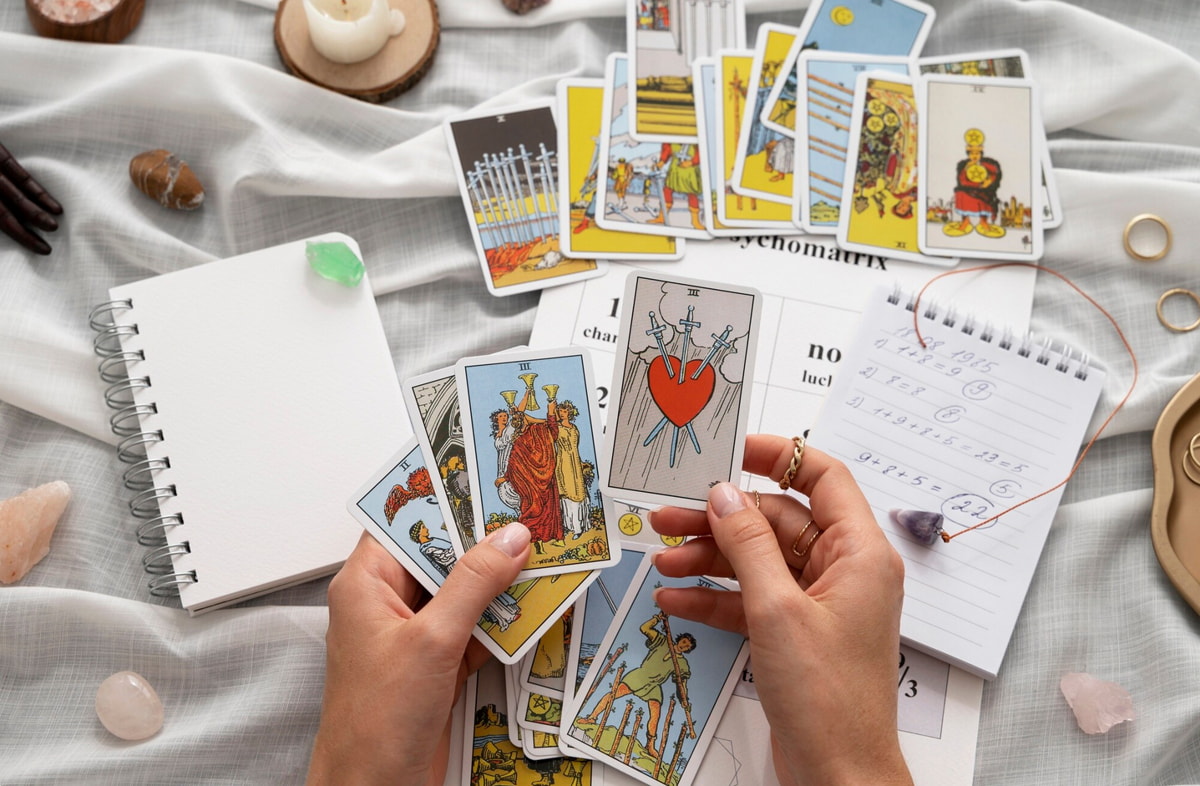
In this article, we’ll guide you through how to perform a tarot reading for yourself, explain key concepts, and help you unlock the wisdom of the cards.
Tarot cards have been used for centuries as a tool for divination, self-reflection, and spiritual guidance. A standard tarot deck contains 78 cards, divided into two main sections: the Major Arcana and the Minor Arcana. The Major Arcana consists of 22 cards representing major life events and spiritual lessons, while the Minor Arcana, made up of 56 cards, deals with the more everyday aspects of life.
While in-person tarot readings have long been a popular method, online tarot readings are becoming increasingly accessible and effective. With just an internet connection, you can perform a tarot reading for yourself, whether it’s through a virtual tarot deck, an app, or even online tarot websites.
Before diving into a tarot reading, it’s essential to set clear intentions. The energy you bring to the reading can shape the outcome, so take a moment to focus your mind and heart. Find a quiet and comfortable space where you won’t be interrupted, and take a few deep breaths to relax. Setting the intention of your reading can help you stay grounded and focused throughout the process.
Consider asking yourself specific questions or thinking about the areas of your life you want insight into. Whether it's a question about love, career, or personal growth, focusing on a specific aspect will give your reading more clarity.
There are many online platforms that offer tarot readings, each with its own unique features. Some provide virtual tarot card pulls, while others offer detailed interpretations. The right tool can make your tarot experience more accessible, insightful, and enjoyable. Here are some different options to consider:
A Yes/No tarot reading is a simple yet effective way to get quick, straightforward answers to specific questions. Many online platforms and apps offer this type of reading, where you can ask a yes or no question, and the cards provide a direct response. It’s an ideal tool for beginners or anyone who needs clarity on a particular issue without the complexity of a full spread.
If you prefer a more in-depth and guided experience, tarot apps might be the right choice. Several mobile apps, such as Golden Thread Tarot and Labyrinthos, allow you to pull cards virtually. These apps typically offer a digital deck with card meanings and interpretations to help guide your reading.
If you’re looking for a more traditional approach or simply want to experience tarot without committing to an app or paid service, many websites offer free online tarot readings. Sites like Biddy Tarot or Tarot.com provide free readings with various spreads, including one-card pulls, three-card spreads, and more.
For those who enjoy a more personal and interactive experience, YouTube channels dedicated to tarot readings can be a great option. Many tarot practitioners upload videos where they perform live readings, or share pre-recorded content that offers valuable insights for self-reflection.
When choosing the right tool for your tarot reading, consider the following factors:
Whether you're drawn to a simple Yes/No tarot reading for quick answers or a more in-depth app for regular self-reflection, selecting the right tool will enhance your tarot practice and bring you closer to the answers you seek.
Once you’ve set your intentions and chosen your online tarot platform, it’s time to begin the reading. If you're using a physical deck in combination with an online platform, you can shuffle the cards as you would traditionally. If you're using a virtual deck, many online tools simulate the shuffling process. Focus on your question or intention as you shuffle and draw your cards.
For beginners, it’s a good idea to start with a simple spread. Here are a few options:
After drawing your cards, it’s time to interpret them. While it may be tempting to rely entirely on the online tool’s interpretation, it’s important to develop your own understanding of the cards. Tarot reading is as much about intuition as it is about the symbolism of the cards. Here’s how to approach interpreting each card:
After interpreting your cards, take time to reflect on the reading. How do the cards' messages align with your current circumstances or challenges? Did anything resonate with you in a personal way? Remember, tarot readings can offer valuable insights, but the final interpretation always lies in your hands. Take a few moments to journal your thoughts or meditate on the reading.
If the reading feels confusing or unclear, that’s okay. Sometimes, tarot provides answers that are not immediately obvious, and it may take time for the full meaning to emerge. Trust the process and allow the wisdom of the tarot to unfold over time.
Like any skill, tarot reading improves with practice. The more you engage with the cards, the deeper your connection and understanding will become. As you grow in your tarot practice, you can experiment with more complex spreads and refine your intuitive reading abilities.
You can also use tarot as a tool for daily or weekly reflection. By doing a daily one-card reading, you’ll begin to notice patterns and themes that provide deeper insight into your life.
Learning how to do a tarot reading for yourself online is an empowering and insightful experience that can offer guidance on various aspects of your life. By setting clear intentions, choosing the right online tool, and trusting your intuition, you can unlock the wisdom of the tarot in the comfort of your own home. Whether you're a beginner or an experienced reader, tarot can be a valuable tool for self-reflection, decision-making, and spiritual growth. So, the next time you need answers, try doing a tarot reading for yourself online and see what the cards have to offer.